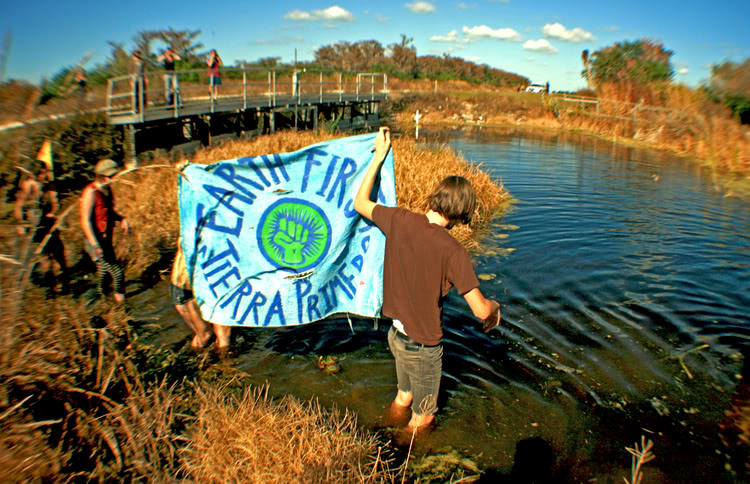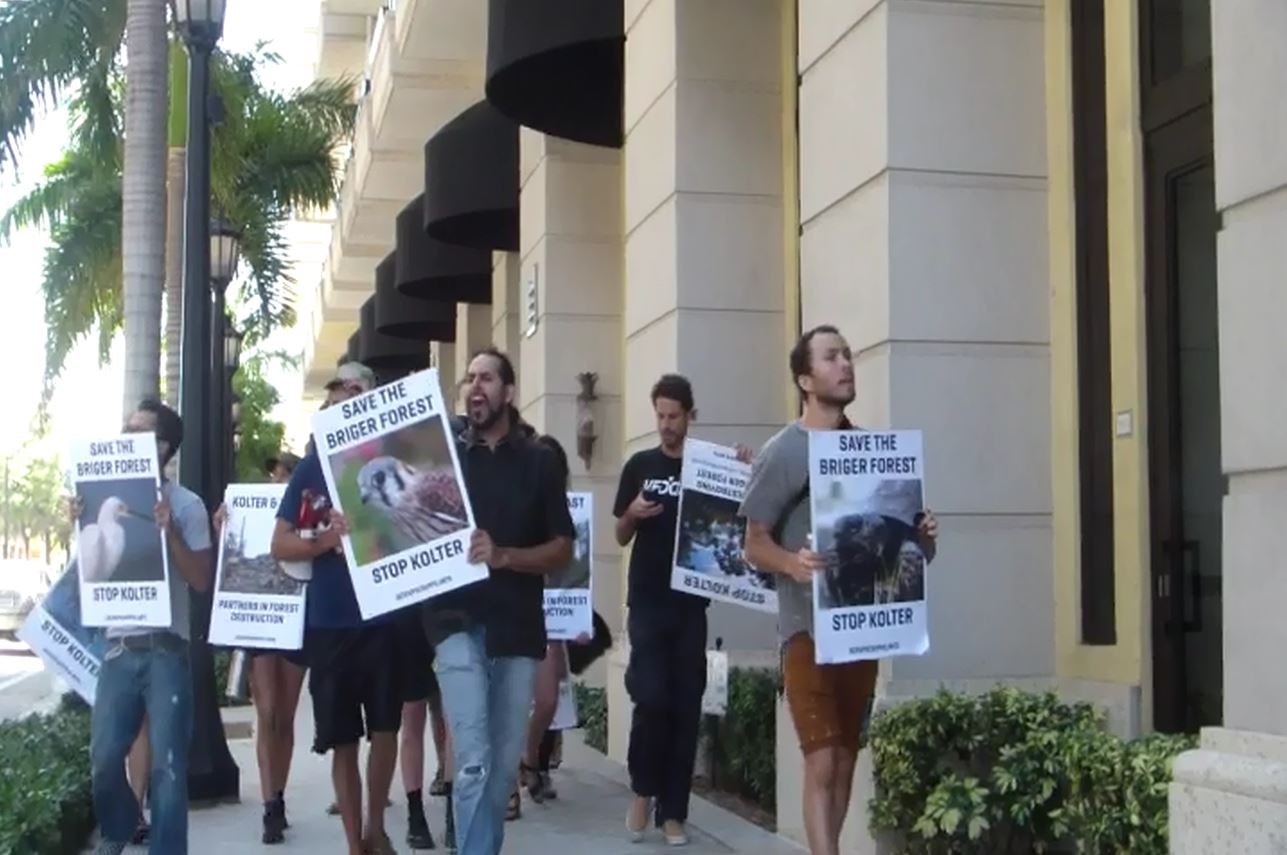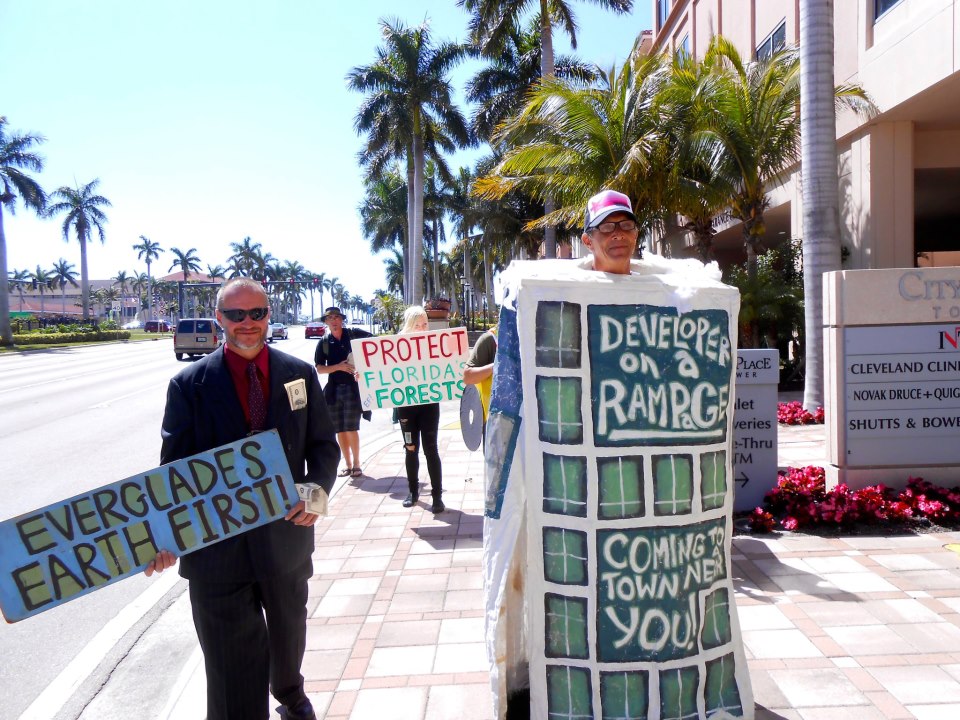Filed under: Analysis, Anarchist Movement, Environment, Southeast

By Panagioti Tsolkas From Earth First! Newswire
“…I guess it’s sort of an anti-technology backlash, anti-globalization. I don’t think that’s a prevalent attitude in this county.” –Bevin Beaudet, Scripps Program Manager for Palm Beach County, USA Today, January 2005
An inside look at how Earth First! has helped keep a burgeoning biotech economy at bay for more than ten years in the venture capitalist mecca of Palm Beach County.
 Twelve years ago, when I joined the effort to stop the planned biotech city in the county where I lived, I didn’t anticipate that we could outlast—in some cases even outlive—our opponents. But that may be the case for our rag-tag group of grassroots activists in a decade-plus fight against the industry’s plans in South Florida.
Twelve years ago, when I joined the effort to stop the planned biotech city in the county where I lived, I didn’t anticipate that we could outlast—in some cases even outlive—our opponents. But that may be the case for our rag-tag group of grassroots activists in a decade-plus fight against the industry’s plans in South Florida.
In 2004, then-Governor Jeb Bush called biotech an “unstoppable train” while unveiling his plans to plow through 6,000 acres of swamp, forest and farm for a biotech city. Two years, several lawsuits and a couple dozen headline-making protests later, his plan lay near-dead in the swamp water of the Northeast Everglades. Scripps, the primary company associated with the plan, did finally drag itself up and open the doors on “Phase I” of their laboratories on a local university campus with a mere 10, 000 square feet of lab space; a minuscule fraction of their initial plan.
Within the last several years, Scripps, the state’s model for the speculated biotech boom, has shown deep internal cracks in its bureaucratic operations and financial stability. With the operation in disarray and opposition still on the move, the next few years could spell the end for what I viewed over ten years ago as a biocentrist’s wildest nightmare.
 From the project’s onset, it was a tale of species extinction, vivisection, deforestation, genetic engineering, urban sprawl, and top-notch political corruption all rolled into one. The backdrop: an imperiled Everglades, the rare ecosystem where vast swamp reaches for the coast line across the southern third of a stranger-than-fiction peninsula.
From the project’s onset, it was a tale of species extinction, vivisection, deforestation, genetic engineering, urban sprawl, and top-notch political corruption all rolled into one. The backdrop: an imperiled Everglades, the rare ecosystem where vast swamp reaches for the coast line across the southern third of a stranger-than-fiction peninsula.
But after a decade of protests in the courts, the commission chambers, the streets, the fanciest of hotels (topless), and the treetops, an effort to stop the development of a biotech hub in the region continues with a level of success that was unanticipated—by both our enemies and ourselves.
I realize it’s not uncommon for grassroots activist-types like me to present a campaign that they’ve busted their ass on as the single most important fight of the planet. I’m trying to resist the urge to do so here. Readers can decide on the magnitude of the project’s Hiaasen-esque heinousness for themselves. I think the most important parts of this story are the lessons of persistence in the realm of environmental activism, and the potential ripple-effect of victories when dealing with decks stacked so high against us.
Scripps Biotech and its Future Executioners
The entity known as Scripps Biotech has been well-masked by a masterful PR campaign promoting itself as a life-saving research institute for badly needed pharmaceutical cures—a nearly impenetrable façade. When the company proposed an expansion of operations in 2004 which would relocate their stronghold from La Jolla, California, to somewhere in swamplandia of the southeastern US, they bought their very own “put it in my backyard” campaign. It featured a shameless astroturf operation where people picketed the first public meetings to discuss opposition to the project, paid for by the proposed real estate developer, with faux protestor, Patty Doherty, claiming that the sooner the Scripps Florida site broke ground, the sooner an elderly parent would be relieved of his battle with Alzheimer’s.
This was the PR icing on top of the usual developer rhetoric of promised jobs and tax-base increases. And then there was the half-billion in public subsidies that Governor Bush had arranged for the deal. Despite my habit of harboring absurdly optimistic tendencies, I recall thinking in those early moments that we were about to get creamed. But I love a challenge, and I hate greedy rich people who want to destroy the planet, so I jumped into the fray.
 A bit of digging beyond the company’s press releases began to tell a different story. Despite the corporate media’s general collusion with Scripps, thankfully there were a few diligent reporters (a dying breed) willing to do the heavy lifting on research, giving additional fuel to our skepticism about the supposed biotech cure-all, from the state’s economy to your grandma’s terminal illness.
A bit of digging beyond the company’s press releases began to tell a different story. Despite the corporate media’s general collusion with Scripps, thankfully there were a few diligent reporters (a dying breed) willing to do the heavy lifting on research, giving additional fuel to our skepticism about the supposed biotech cure-all, from the state’s economy to your grandma’s terminal illness.
Thanks to some muckraking journalists, any synopsis of the anti-Scripps sentiment was likely to include such tidbits as: a close relationship to biotech giant Novartis surrounding the promotion of an anti-lactation drug to bolster formula companies in developing countries; patents on biopharming plans to splice corn plants with herpes vaccines; and a history of animal abuse violations including tests on what happens to pregnant cats when exposed to music blaring in their ears for long periods to time… That’s just for starters. If it involves corporate profiteering off of genetic modification, nanotech paticles, robots, bio-warfare, geoengineering, or other such dystopic sci-fi themes, Scripps has likely worked on it.
When the Scripps Florida plan started on its 6,000 acre biotech metropolis smack in the middle of the Hungryland Slough’s historic flow way into the Loxahatchee River, the bureaucrats of the time attempted to quash opposition by inviting key environmentalists on board, essentially to help decide what the landscaping plans should look like.
 Lucky for those of us who decided to stand in the way, rather than sit at the table, the initial project far overstepped and rapidly shattered the feel-good biotech/biology alliance, ramrodding through the public permitting process by gagging permit agency staff. Even some of the more moderate end of the table walked away and committed to fight in court against an approval of the project, calling it a Trojan Horse being used to bust open a vast region of the northeast Everglades that still remained without urban infrastructure. The politicians’ promise of taxes and jobs couldn’t override the fact that something was grossly wrong about the deal.
Lucky for those of us who decided to stand in the way, rather than sit at the table, the initial project far overstepped and rapidly shattered the feel-good biotech/biology alliance, ramrodding through the public permitting process by gagging permit agency staff. Even some of the more moderate end of the table walked away and committed to fight in court against an approval of the project, calling it a Trojan Horse being used to bust open a vast region of the northeast Everglades that still remained without urban infrastructure. The politicians’ promise of taxes and jobs couldn’t override the fact that something was grossly wrong about the deal.
But still the majority of vocal opposition shied away from taking a stance about Scripps as a whole, choosing to focus on the land use battle.
After all, Governor Jeb had teamed up with the Palm Beach County Commission to come up with over 500 million dollars in corporate welfare between the State and County budgets to drop into the pot for the biotech venture capitalists. This force was coupled with local land barons and their developer minions expecting people to flock to the envisioned biotech city. The real estate flies came swarming around the already-swollen housing bubble, hoping to wager on one more round of sprawl-speculating before the inevitable burst that they knew was around the corner.
The County bought up Mecca Farms practically before anyone could get a word in edgewise. It was 2,000 acres of orange groves which had reportedly caved under the pressure of global free trade deals. Another 4,000 acres of adjacent wild ranch land owned by Charlie Vavrus was poised for re-zoning under an epic suburban planning clusterfuck that the County called its BioScience Research Protection Overlay District.
What they didn’t account for was a growing hatred of all things Bush-related accompanied by a rising love for the Everglades watershed among some youthful activists. And the appearance of Earth First! in the region. Fresh off the streets of the 2003 Free Trade Area of the Americas (FTAA) protests in Miami, we were a mix of seasoned activists and newly-radicalized organizers turned our sites on what looked like the clearest indication of global capitalism sinking its teeth into our home turf.
For myself, I had spent the previous several years in a mix between street protests at global trade summits and backwoods campaigns on the west coast of the U.S., where treesits and road blockades aimed to protect forests from industrial logging. I was anxious to get back to what I considered home and apply my experiences closer to the place where I lived.
By 2005, the presence of our new, radical element in the local environment movement was making bureaucrats and investors sweat.
In January of that year nine people were arrested after locking themselves to banisters inside the Business Development Board’s (BDB) office lobby and dropping an anti-Scripps banner off the rooftop. In the course of the protest, another anonymous group entered the office and dumped buckets of rotten oranges in the lobby, clearing the place out and escaping without being apprehended.
Bevin Beaudet, the County’s Scripps Program Manager at the time, captured the bumbling confusion and disbelief following the BDB office occupation: “…I guess it’s sort of an anti-technology backlash, anti-globalization. I don’t think that’s a prevalent attitude in this county.” That was his actual quote in national news outlets.
He also told the news that we didn’t look like mainstream citizens. He was right. The protest came directly following a week-long camp of trainings, workshops and meetings. By that point, we likely looked as wild as we smelled.
Then there was John R. Smith, a right-wing commentator for the Sun Sentinel newspaper who’s op-ed accused us of trying to destroy all of American civilization by challenging Scripps. (His words, by the way, still spread joy and laughter when recited around our campfires today.)
We didn’t care. We effectively shut down business for the day and hit national news. The story of our action was picked up by the Associated Press, and by the end of the day, millions would read about our fight, with headlines reaching mainstream outlets including USA Today, casting doubt on Beaudet’s presumption about prevalent attitudes. Battle lines were drawn, and our opponents attempts to paint us as filthy outcasts only seemed to highlight their own dirty dealings.
In fact, we had targeted the BDB in that action specifically because they had just gotten busted in a corruption scandal where representatives of the chamber-of-commerce-esque entity, Greg Fagan and Larry Pelton, were disgraced for grossly misusing public funds allocated to promote the Scripps project and arrange deals with developer friends.
From that point on, the county would be wracked by developer-related scandal and corruption for years to follow. Time Magazine would later name Palm Beach the “Corruption Capital of Florida”—which could be a hotly contested title in a state listed as one of America’s most corrupt.
And while voices from liberal environmental groups in the region took it upon themselves to bicker about whether our actions were justified, the response we got from the so-called mainstream citizens was one of resounding encouragement to keep the pressure on.
So we did. Even though the state attorney was attempting to stick us with the cost of damaging the fancy rug for the rotten-orange incident, several of the arrestees from the BDB action took their charges all the way to trial pleading that their efforts were not a crime but a urgent public service announcement akin to something like Paul Revere’s midnight ride.
The rug charges didn’t stick, and their effort to intimidate us fell flat as we promptly started planning our next action.
For the following two years environmental attorneys worked in tandem with local residents and grassroots organizers to keep the fight on the headlines and in front of judges—civil and criminal alike.
In the winter of 2006, several anarchists local to south Florida started a regional Earth First! group and made a bid to host the movement’s national annual gathering in the swamp land of the J.W. Corbett Wildlife Management Area—a state-owned parcel of near 70,000 wild acres, adjacent to other public land reaching all the way to Lake Okeechobee, creating a bulk of the massive ecological corridor, the Loxahatchee River watershed, also known as the Northeast Everglades.
Up until the previous year, the Corbett was little known outside the realm of local hog hunting enthusiasts, as well as the occasional bird-watcher and seasonal attendees of the regional Everglades Youth Camp located within it. But the lush forested swamp land was now on the map, thanks to the proposed biotech city planning to be next door neighbors. The locals generally preferred the idea of peace and quiet (interspersed with the occasional shotgun blast and revving swamp buggy engine), and some turned out their hook-and-bullet clubs against the Scripps plan too.
It’s safe to say that not all the hunters and rednecks were pumped about a mob of hippies and anarchists descending on their stomping ground. But there were some unlikely bonds formed across cultural boundaries there, further strengthened by the support of biologists who staffed the wildlife area also standing up to the Scripps plan.
Emboldened by new-found cross-cultural relationships and the momentum towards defeating the Scripps proposal, the ad hoc group which would later become Everglades Earth First!, planned a follow up to their 2005 action at the Business Development Board. This time we’d hit a bit closer to home for Scripps.The organizers of the 2006 Earth First! winter gathering were compelled to take things a step further by making the event an international affair, with environmental and indigenous rights activist-attendees from Ecuador, Guatemala, Puerto Rico, Venezuela, the Dominican Republic, and the Independent Traditional Seminole Nation whose stolen land we were gathering on.
The gathering happened to coincide with an industry conference, BioFlorida, which focused on building morale for Scripps’ investors in our county which they were planning to establish as a flagship for the state’s new biotech economic engine.
Our attack would be two-pronged, starting with a visit to Scripps’ then-CEO Richard Lerner’s newly-purchased multi-million dollar beach house on the elite Jupiter Island. With no one home to call the police immediately, people spontaneously initiated a roof top photo shoot and left messages of our presence around the house, backyard and beach entrance, including a massive seaweed mural above the high-tide line reading “F*ck Biotech, Go Manipulate Yourself.”
Lerner’s home was chosen, as he was a founder of Scripps Biotech that had been exposed for leading participation in “scientific” research linked to the Tobacco Papers, where pseudo-science aimed to downplay the harmful effects of cigarette smoke through decades of pointless industry-funded animal testing.
Next, EF!ers crashed the BioFlorida conference with a stealthily executed dropping of a giant banner reading “No Biotech, No Compromise” off the roof top of Marriott Hotel who hosted the conference in downtown West Palm Beach. Despite a heavy security presence, the banner-droppers were able to sneak in and out without notice, later to rejoin a noisy demonstration of several dozen people in front of the hotel.
Demonstrations against Scripps continued almost weekly throughout the year, with highlights including: a topless disruption of Governor Bush’s visit to a Scripps board meeting in the Breakers Hotel on Palm Beach Island; a fly-over of the groundbreaking ceremony with an anti-Scripps banner tailing a plane rented by neighbors opposed to the project; numerous evictions from the County Commission chambers; and a late night mission to lock the gates of the construction site on April First, accompanied by a spoof press release that the project had been cancelled and all construction abandoned.
First they ignore, then they laugh, then they retaliate… Then you win.
By the end of 2006, a federal judge made the April Fools’ hoax come true by declaring that the permitting process for the project was officially whack. Despite having already cleared the farm land and laid concrete foundations, the ruling was clear: it would be years before permits would ever be granted for the needed infrastructure to open up a biotech city on Mecca Farms and Vavrus Ranch.
We threw a party and celebrated the unexpected alliance that resulted in a sweet victory. Public pressure sent Scripps Florida to the drawing board, set back by a loss of millions in failed land deals and lawsuits. Had it been Scripps’ own money, it might have dealt the death blow there and then. But the industry allies just dug deeper into the public coffers. By 2009 the project re-surfaced with the County budget showing that of the overall tax increase from the previous year, 33% had gone directly to recouping the cost of losing the Scripps fight at Mecca Farms.
By that point, the broad opposition to Scripps had been significantly dispersed by the indefinite delay of our victory, other pressing efforts in the region, and an informal deal by the environmental attorneys on the case that they would not challenge the Scripps project in other arenas.
But Everglades Earth First! had cut its teeth on this effort and we decided we would not to let up on stopping the biotech city, no matter where it surfaced. So when the County and Scripps announced their new plan in 2007 to scale down to 683 acres closer to the eastern urban corridor, we did not applaud their flexibility and good-sportsmanship in not filing appeals to the victorious lawsuit from Mecca. Rather, we scouted the forest and wetlands that were being offered up to the chopping block by our former allies. A few members of our rag-tag group got pleasantly lost in wandering the flatwoods, noting the mingling of native slash pines and saw palmettos with invasive exotics creeping in. They called it the Briger Tract. We decided to call it the Briger Forest.
Resistance, Phase II
The next four years would see a revival of the anti-Scripps direct action campaign, laced with new litigation efforts and permit challenges. This time led by Earth First!, rather than the Big Green compromisers. And in sticking to our guns, we even won some of those allies back. The local Sierra Club, for example, eventually came around to admit that they didn’t actually want to endorse destroying threatened and endangered species in a rare forest ecosystem that they had actually never been to prior to making a deal against it.
They joined our legal challenges and protests, and even invited people from the group to run for committee seats on their local Sierra group’s board, which we did successfully.
By 2010, members of our group had given ourselves crash courses on administrative and appellate law, grant-writing and biological surveying. We had walked most every corner of the property with a band of volunteer amateur surveyors.
It didn’t take a PhD to figure out that the permits for this plan were also bogus. For example, where the developers research only turned up two sighting of endangered hand ferns, we were able to locate, photograph and mark GPS coordinates for 55. We also marked dozens of gopher tortoise burrows not mentioned by the developers’ consultants, even placing wildlife cameras at some to monitor for additional protected species, such as the eastern indigo snake.
We faced off with a room full of lawyers from the primary state permitting agency, the South Florida Water Management District (SFWMD) and their corporate overlords. As pro-se petitioners, we conducted days of giving testimony and presenting evidence on the Conceptual Environmental Resource Permit (ERP), then filed an extensive appeal chock full of case law citations. It came down to petty details such as SFWMD saying that hand ferns being wetland-dependent species didn’t classify them as wetland species, therefor they ignored their endangered status entirely… When our appeal to the Fourth District came back “affirmed per curium,” we had to face a hard truth: there were limits to playing someone else game.
But our paper-wrenching stalled them, drove up their costs, forced them into the light a little bit more, and inspired other communities to fight back too..
In one example, we met with residents in the historically Black community of Limestone Creek, several miles north of the Briger forest, who were facing the development of a “biotech spinoff,” dealing primarily with bio-waste, bordering their neighborhood on an 82 acre parcel of forested land. This classic case of environmental racism was challenged, and appears to still be on hiatus.
Taking to the trees
In February of 2011, preparing for imminent construction with the approval of the ERP, we built the first Florida treesit village. And though bulldozers did not roll, we spent 6 weeks occupying the forest with multiple treesits, showing them that we were escalating our tactics and building mass support. Some of the treesits were visible from very major roads, like I-95, with thousands passing every hour, honking and sometimes stopping to shout support and encouragement.
When that ended with treesitters arrested and trees pointlessly cut, we responded by filing a formal investigation into the police for cutting without permits… and treesitting the large slash pine in front of City Hall. It was another April Fools’ Day media stunt, but with a more somber tone, with our banner reading “Cutting Forests is No Joke.”
The bulldozers never came that year, or the next. Still, we did not relent; we continued to build pressure. When the Occupy Wall Street wave swept the country, we supported out local encampment with direct action trainings and banners decrying the corporate welfare handouts to Scripps. When a local animal rights group began tackling vivisection by doing home and office visits, organizers with the anti-Scripps fight joined forces, inspiring similar tactics in the Briger fight.
Builders met with blockades
Then in November 2014, two months after the failure of an appeal on a significant permit challenge filed pro-se by members of the EF! group and the local environmental coalition of grassroots activists, bulldozers did begin to roll on Briger. After several years of developing intimate connections to the forest, we wouldn’t let them start without a fight.
A developer called Kolter started by building an access road that never appeared in the initial permits, we responded by blocking the road with the disabled van and people locked to it, holding them off for a morning and bringing headlines, once again to the Scripps fight, from the moment of the arrests to the days of trial.
From there a new range of tactics blossomed. There was a reported tree-spiking in the forest, threatening damage to any wood that may be milled or chipped. While this never actually got verified, the anonymous communique about it put the developers on notice, and again, attracted media interest. Anonymous activists also located the home of the developer contracted for the construction, Kolter CEO Bobby Julian, and blockaded the driveway of his house, leaving a banner attached to his gate, and generating more news.
On a near weekly basis throughout 2015, protests would occur at the Kolter offices in the middle of downtown West Palm Beach as well, forcing them to lock their doors and limit their business operations whenever the demonstrations occurred. In one case, the office was occupied with people locking themselves together inside.
In this period, a new round of administrative legal challenges were filed, with a focus on the existence of a Hazardous Waste Management Plan (HWMP), as required by the ERP. As a result of our challenges, an HWMP was created, but it was essentially useless to protect the public from the transport and disposal of toxic waste from the labs.
Simultaneously, a national news report on the chronic problem of under-reported biolab waste accidents across the country hit the headlines. An interactive map of U.S. incidents and related scandals was produced by USA Today, highlighting what we had suspected all along. The record of Scripps Florida’s lacking transparency and oversight in their Phase I labs at the FAU campus make them a prime candidate for future toxic disasters.
 Today, Kolter has cut into nearly half of the forest’s 683 acres for what they call the Alton Town Center That’s not to be confused with the Abacoa Town Center, built across the street in the late ‘90s, which was nearly abandoned and went into foreclosure in 2010. Just last year, Wells Fargo sold the repossessed Abacoa Town Center at a 64 percent loss.
Today, Kolter has cut into nearly half of the forest’s 683 acres for what they call the Alton Town Center That’s not to be confused with the Abacoa Town Center, built across the street in the late ‘90s, which was nearly abandoned and went into foreclosure in 2010. Just last year, Wells Fargo sold the repossessed Abacoa Town Center at a 64 percent loss.
Ironically, Scripps Biotech is no longer front and center in the Briger/Alton PR. In fact, it’s questioned by many as to whether or not a Phase II lab is even still in the Alton plans. As recent as 2014, Scripps was reporting a $21 million dollar deficit in its budget and scrambling to find competent leadership.
In the meantime, the current company making use of the corporate welfare in Scripps place is United Technologies, of the Acreage cancer cluster fame. And the struggle continues.
—————–
Panagioti Tsolkas has been an organizer with Everglades Earth First! and co-chair of the Palm Beach County Environmental Coalition since the beginning of the campaign against Scripps Biotech. He is also a former editor of the Earth First! Journal and currently organizes with the Campaign to Fight Toxic Prisons and an ad hoc group fighting Sabal Trail, a new fracked gas pipeline through the southeast.






